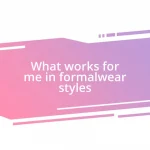Key takeaways:
- Fashion icons, such as Audrey Hepburn and Rihanna, influence personal identity and self-expression, often embodying cultural movements through their style choices.
- Characteristics of fashion icons include confidence, originality, cultural relevance, versatility, and their significant impact on trends, inspiring others to explore their own fashion narratives.
- Social media has transformed fashion engagement by allowing diverse expressions of style and amplifying emerging designers, while also posing challenges like the pressure for perfection in personal branding.
![]()
Understanding Fashion Icons
Fashion icons are more than just celebrities or trendsetters; they embody the spirit of their times while influencing style in lasting ways. I often think back to my college days, flipping through magazines and finding inspiration in the bold choices of figures like Audrey Hepburn or Rihanna. Their unique styles helped me discover my own identity and the power of self-expression through clothing.
What strikes me is how these icons channel emotions through their fashion choices—think of how Lady Gaga’s daring outfits challenge societal norms. I remember feeling exhilarated the first time I tried on something that felt out of my comfort zone. Isn’t it fascinating how a single outfit can empower someone to step into a completely new persona?
The impact of fashion icons reaches far beyond mere aesthetics; they become symbols of cultural movements and societal changes. When I see images of icons advocating for diversity and body positivity, I can’t help but reflect on the responsibility they carry. It’s a reminder that fashion can serve as a powerful platform for change, urging us all to consider the messages we send through our personal style choices.
![]()
Characteristics of a Fashion Icon
To me, the characteristics of a fashion icon are both subtle and striking. It’s not just about wearing the latest trends; it’s about owning a look and conveying a message through sartorial choices. I recall a time I tried to emulate the effortless chic of a style icon I admired—you know, that moment when you look in the mirror and realize you feel like a whole new person. It’s this mastery of self-presentation that sets true fashion icons apart.
Here are some defining characteristics I often notice in fashion icons:
- Confidence: They wear their outfits like armor, radiating an undeniable self-assuredness.
- Originality: Icons redefine norms, often creating unique styles that others latch onto.
- Cultural Relevance: They reflect and respond to societal trends, making them relatable figures.
- Versatility: They can effortlessly shift from glamorous to casual, showing a range of fashion fluency.
- Influence: Their choices inspire trends, impacting not just the runways but also everyday wardrobes around the world.
An example that comes to mind is when I first experimented with bold prints and colors as a nod to an icon who blended patterns in ways I’d never considered. It was nerve-wracking at first, but it opened up a world of creativity in my wardrobe.
![]()
Influential Fashion Icons in History
When I reflect on influential fashion icons throughout history, names like Coco Chanel and Alexander McQueen immediately come to mind. Chanel’s introduction of the little black dress revolutionized women’s fashion, creating a timeless staple that speaks to elegance and practicality. I can still vividly remember the first time I wore a similar piece; it felt like stepping into a legacy of sophisticated style that transcends generations. Then there’s McQueen, whose theatrical designs challenged conventions and made powerful statements, reminding us that fashion can be art.
There’s something powerful about the way fashion icons communicate not just through clothing, but also through their life journeys. For instance, Michelle Obama’s elegant and relatable style celebrated inclusivity and resonated with many people, including myself. Watching her confidently sport both high-end designers and affordable brands taught me the importance of expressing individuality in every price range. I’m always encouraged by how these icons manage to inspire others while remaining true to themselves.
Let’s not forget the boldness of icons like Marilyn Monroe, whose glamorous allure both captivated and empowered women. I remember attending a themed event where I channeled her iconic style and felt an electric mix of confidence and nostalgia. It’s incredible to think how these figures shape cultural conversations around beauty and identity, making us question and redefine our own perceptions of fashion.
| Fashion Icon | Impact on Fashion |
|---|---|
| Coco Chanel | Introduced the little black dress; revolutionized women’s wear with elegance and simplicity. |
| Alexander McQueen | Challenged traditional norms; created theatrical designs that pushed the boundaries of fashion. |
| Michelle Obama | Celebrated inclusivity and relatability; demonstrated that personal style transcends price. |
| Marilyn Monroe | Embodied glamour; inspired confidence and redefined ideals of beauty. |
![]()
Modern Fashion Icons to Follow
When I think of modern fashion icons, a name that instantly comes to mind is Zendaya. Her style journey is a beautiful blend of daring and refined looks that defy categorization. I can still remember the moment she stunned everyone at the Met Gala in that breathtaking gown. It made me realize how powerful personal expression through fashion can be. Do you remember the outfit that made you feel unstoppable? For me, it was an oversized blazer and combat boots—Zendaya’s boldness nudged me to try something unexpected.
Another icon worth following is Billie Eilish. She has an uncanny ability to carry the conversation about body positivity and self-acceptance through her ever-evolving style. I recall how her baggy, layered outfits challenged conventional beauty standards in a way that resonated with my own journey of finding comfort in my skin. Every time she steps out, it’s a reminder that fashion isn’t merely about fitting in; it’s about making a statement and owning your uniqueness. How liberating is it to wear what feels authentic?
Lastly, I can’t overlook Harry Styles, who redefined gender norms in fashion with his eclectic mix of vintage and high-fashion pieces. His unapologetic flair for combining traditionally masculine and feminine elements inspires many, including myself. I once tried to channel his vibe by pairing a floral shirt with tailored trousers. The experience was exhilarating! It really opened my eyes to how fashion can be a form of self-discovery—what’s your go-to style that reflects your personality? It’s a question worth pondering, as these modern icons continually give us the courage to express who we truly are.
![]()
How to Incorporate Iconic Styles
Incorporating iconic styles into your wardrobe can be both a fun experiment and a meaningful expression of who you are. One method I love is mixing and matching elements from different eras. For instance, I recently paired a vintage Chanel-inspired tweed jacket with modern high-waisted jeans, creating a fresh take on a classic look. Have you ever tried blending styles? It can reveal unexpected dimensions of your personal aesthetic.
Another impactful approach is to be inspired by an icon’s signature elements. Take Audrey Hepburn’s love for minimalist elegance as an example. Wearing a classic white button-up shirt tucked into tailored trousers instantly transports me to her world of timeless charm. This not only makes me feel polished but also puts a bit of that iconic sophistication into my daily routine. What signature elements resonate with you?
It’s also important to remember that iconic styles often come with a unique story. When I wore a bold, statement belt reminiscent of Alexander McQueen’s designs to a gathering, I caught everyone’s attention. Instantly, it sparked conversations about creativity in fashion and the stories behind our choices. Embracing these iconic symbols can transform not just your outfit but also the atmosphere around you. Have you experienced the power of a statement piece?
![]()
Fashion Icons and Personal Branding
Fashion icons significantly shape personal branding, serving as powerful examples of how style can communicate individuality and values. I remember attending a workshop where we analyzed the branding strategies of figures like Rihanna. Her style is a fusion of high fashion and streetwear, reflecting her journey from music to beauty mogul. This taught me that clothing choices can articulate not just personal taste but also the narrative of who we are or aspire to be. Have you ever considered how your outfit might tell your story?
The choice of clothing, colors, and overall aesthetic truly integrates into one’s identity. I once noticed how my friend effortlessly radiated confidence in a bright red dress at a networking event. It was more than just a pretty outfit; her choice proclaimed boldness and readiness to take on challenges. In that moment, I realized that certain styles can convey messages—subtle yet potent. What do your clothes say about you?
Additionally, successful personal branding through fashion often relies on consistency. Think about Steve Jobs and his iconic black turtleneck. He simplified his wardrobe to focus on his work. I’ve tried adopting a capsule wardrobe, where every piece echoes my personal ethos, and it’s been transformative. My outfits now spark conversations that align with who I want to be—a creative thinker and innovator. How does your fashion reflect your brand?
![]()
The Impact of Social Media
Social media has revolutionized the way we perceive and engage with fashion icons. Platforms like Instagram and TikTok allow anyone to curate their personal style while showcasing inspirations from around the globe, creating a melting pot of fashion ideas. I’ve found that scrolling through these feeds often sparks my creativity—like the time a vintage-inspired outfit I saw online encouraged me to incorporate bolder patterns into my wardrobe. Have you ever stumbled upon a look that completely transformed your perspective on style?
Additionally, social media amplifies the voices of emerging designers and fashion influencers. It’s fascinating how trends can explode overnight thanks to a single viral post. I recall discovering an up-and-coming designer through a friend’s story; their unique approach inspired me to explore lesser-known brands. This accessibility fosters a fashion community that thrives on collaboration and celebration over competition. What hidden gems have you found through social media?
Yet, the impact isn’t entirely positive; the pressure to maintain a perfectly curated image can be overwhelming. I’ve personally felt the weight of comparing my everyday looks to curated feeds filled with flawless outfits. It’s important to remember that authenticity should reign over the pursuit of perfection. Have you found the balance between inspiration and self-acceptance in your social media experience?













